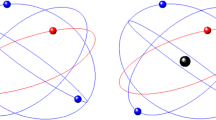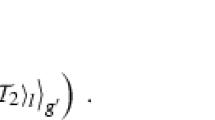Abstract
In an axially symmetric three-dimensional Riemann-spaceg ik(u 1,u 2)−u 3 represents the cyclic parameter-, a gravitational potential ϕ(u 1,u 2) is given. For all masspoints with equal total energy and equal angular momentum there exists a function Ψ(u 1,u 2) by means of which the equations of motion can be reduced to a simple ordinary second-order differential equation. The function ϕ can be interpreted as the velocity with which the masspoint moves in the two-dimensional spaceu 1,u 2.
Of particular interest is the case where the spaceu 1,u 2,u 3 is Euclidean. Ifu 1,u 2 are Cartesian coordinates in a planeu 3=const., and if the tangent vector of the trajectoryu 1(t)u 2(t) has the components cosω, sinω it is shown that the triple integral
is an invariant integral in Cartan's sense, in other words, if the integral is extended over a domain in a meridian plane at timet=0, it keeps its value at any time.
Similar content being viewed by others
References
Cartan, E.: 1922,Leçons sur les invariants intégraux, A. Hermann, Paris.
Knothe, H.: 1959, ‘Some New Methods of Satellite Orbit Calculations’, Xth Internat. Astron. Congress, London.
Author information
Authors and Affiliations
Rights and permissions
About this article
Cite this article
Knothe, H. Satellites and Riemannian geometry. Celestial Mechanics 1, 36–45 (1969). https://doi.org/10.1007/BF01230631
Received:
Issue Date:
DOI: https://doi.org/10.1007/BF01230631




